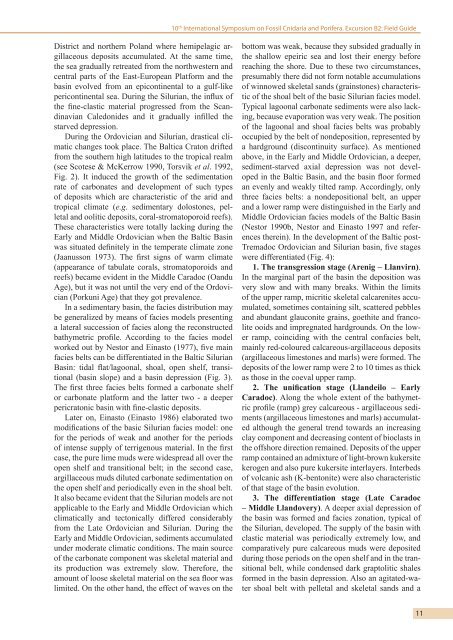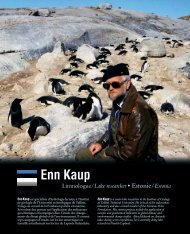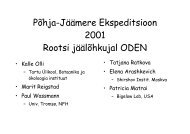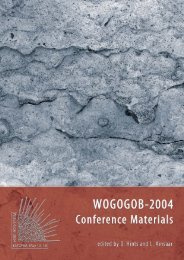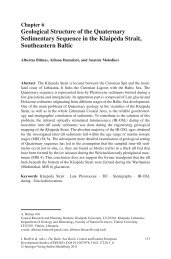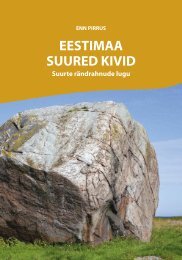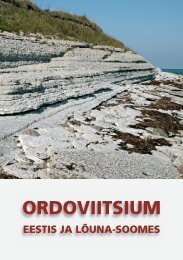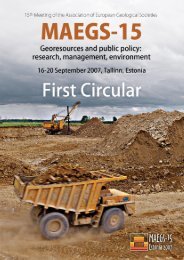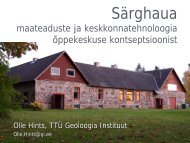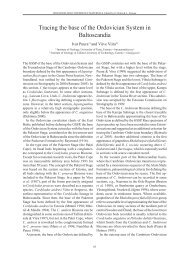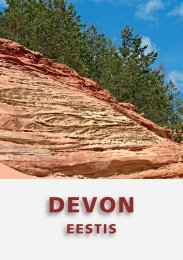Excursion Guidebook - Geoloogia Instituut
Excursion Guidebook - Geoloogia Instituut
Excursion Guidebook - Geoloogia Instituut
Create successful ePaper yourself
Turn your PDF publications into a flip-book with our unique Google optimized e-Paper software.
10 th International Symposium on Fossil Cnidaria and Porifera. <strong>Excursion</strong> B2: Field GuideDistrict and northern Poland where hemipelagic argillaceousdeposits accumulated. At the same time,the sea gradually retreated from the northwestern andcentral parts of the East-European Platform and thebasin evolved from an epicontinental to a gulf-likepericontinental sea. During the Silurian, the influx ofthe fine-clastic material progressed from the ScandinavianCaledonides and it gradually infilled thestarved depression.During the Ordovician and Silurian, drastical climaticchanges took place. The Baltica Craton driftedfrom the southern high latitudes to the tropical realm(see Scotese & McKerrow 1990, Torsvik et al. 1992,Fig. 2). It induced the growth of the sedimentationrate of carbonates and development of such typesof deposits which are characteristic of the arid andtropical climate (e.g. sedimentary dolostones, pelletaland oolitic deposits, coral-stromatoporoid reefs).These characteristics were totally lacking during theEarly and Middle Ordovician when the Baltic Basinwas situated definitely in the temperate climate zone(Jaanusson 1973). The first signs of warm climate(appearance of tabulate corals, stromatoporoids andreefs) became evident in the Middle Caradoc (OanduAge), but it was not until the very end of the Ordovician(Porkuni Age) that they got prevalence.In a sedimentary basin, the facies distribution maybe generalized by means of facies models presentinga lateral succession of facies along the reconstructedbathymetric profile. According to the facies modelworked out by Nestor and Einasto (1977), five mainfacies belts can be differentiated in the Baltic SilurianBasin: tidal flat/lagoonal, shoal, open shelf, transitional(basin slope) and a basin depression (Fig. 3).The first three facies belts formed a carbonate shelfor carbonate platform and the latter two - a deeperpericratonic basin with fine-clastic deposits.Later on, Einasto (Einasto 1986) elaborated twomodifications of the basic Silurian facies model: onefor the periods of weak and another for the periodsof intense supply of terrigenous material. In the firstcase, the pure lime muds were widespread all over theopen shelf and transitional belt; in the second case,argillaceous muds diluted carbonate sedimentation onthe open shelf and periodically even in the shoal belt.It also became evident that the Silurian models are notapplicable to the Early and Middle Ordovician whichclimatically and tectonically differed considerablyfrom the Late Ordovician and Silurian. During theEarly and Middle Ordovician, sediments accumulatedunder moderate climatic conditions. The main sourceof the carbonate component was skeletal material andits production was extremely slow. Therefore, theamount of loose skeletal material on the sea floor waslimited. On the other hand, the effect of waves on thebottom was weak, because they subsided gradually inthe shallow epeiric sea and lost their energy beforereaching the shore. Due to these two circumstances,presumably there did not form notable accumulationsof winnowed skeletal sands (grainstones) characteristicof the shoal belt of the basic Silurian facies model.Typical lagoonal carbonate sediments were also lacking,because evaporation was very weak. The positionof the lagoonal and shoal facies belts was probablyoccupied by the belt of nondeposition, represented bya hardground (discontinuity surface). As mentionedabove, in the Early and Middle Ordovician, a deeper,sediment-starved axial depression was not developedin the Baltic Basin, and the basin floor formedan evenly and weakly tilted ramp. Accordingly, onlythree facies belts: a nondepositional belt, an upperand a lower ramp were distinguished in the Early andMiddle Ordovician facies models of the Baltic Basin(Nestor 1990b, Nestor and Einasto 1997 and referencestherein). In the development of the Baltic post-Tremadoc Ordovician and Silurian basin, five stageswere differentiated (Fig. 4):1. The transgression stage (Arenig – Llanvirn).In the marginal part of the basin the deposition wasvery slow and with many breaks. Within the limitsof the upper ramp, micritic skeletal calcarenites accumulated,sometimes containing silt, scattered pebblesand abundant glauconite grains, goethite and francoliteooids and impregnated hardgrounds. On the lowerramp, coinciding with the central confacies belt,mainly red-coloured calcareous-argillaceous deposits(argillaceous limestones and marls) were formed. Thedeposits of the lower ramp were 2 to 10 times as thickas those in the coeval upper ramp.2. The unification stage (Llandeilo – EarlyCaradoc). Along the whole extent of the bathymetricprofile (ramp) grey calcareous - argillaceous sediments(argillaceous limestones and marls) accumulatedalthough the general trend towards an increasingclay component and decreasing content of bioclasts inthe offshore direction remained. Deposits of the upperramp contained an admixture of light-brown kukersitekerogen and also pure kukersite interlayers. Interbedsof volcanic ash (K-bentonite) were also characteristicof that stage of the basin evolution.3. The differentiation stage (Late Caradoc– Middle Llandovery). A deeper axial depression ofthe basin was formed and facies zonation, typical ofthe Silurian, developed. The supply of the basin withclastic material was periodically extremely low, andcomparatively pure calcareous muds were depositedduring those periods on the open shelf and in the transitionalbelt, while condensed dark graptolitic shalesformed in the basin depression. Also an agitated-watershoal belt with pelletal and skeletal sands and a11


